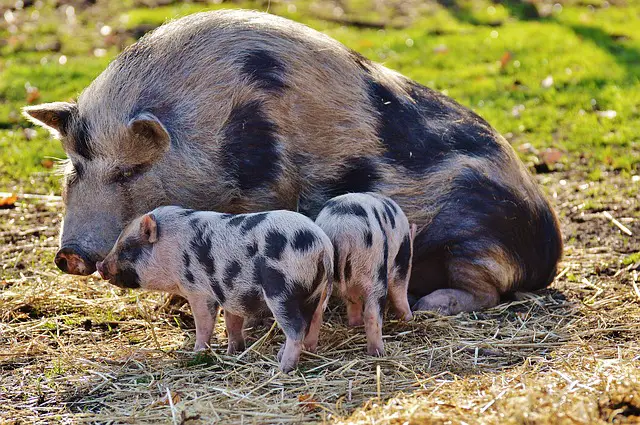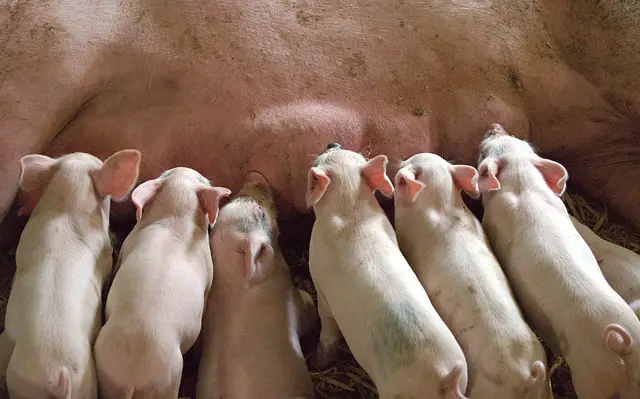It’s important to understand a pig’s reproductive cycle and find out whether they have periods too if you want to prepare yourself for possible bloody surprises.
Do Pigs Have Periods and Bleed?Pigs do not have menstrual cycles, but they go through estrus cycles, which is quite similar to menstruation. This is more commonly referred to as a period when a female pig is “in heat”. This happens for 3 to 5 days every 21 days and can start as early as the pig’s 12th week.
How is an estrous cycle different from a menstrual cycle?
For one, those that have menstrual cycles (like humans) can be sexually active anytime. Those with estrous cycles, however, will only be sexually active during the estrus cycle.
Also, during a menstrual cycle, the endometrium (or that mucous membrane that lines up the uterus) is shed. This turns into the blood discharged by the female during the cycle.
But for pigs, their endometrium is reabsorbed by their system if the pig does not become pregnant while they are in heat.

What Happens When Pigs are In Heat
Be prepared to see your pig go through different changes the moment it starts its estrus cycle.
Behavioral Changes
For one, pigs go through erratic or weird behavior while they are in heat the same way a woman would have PMS. They would pee everywhere and forget any potty training you’ve had so far.
If your pig is left outdoors, it may also start looking for an eligible bachelor to mate with. So you have to consider putting up some fencing if you don’t really keep your pet inside the house.
You may also notice an evident lack of appetite in your pig.
For male pigs, they also go through erratic behavior when they go into heat. Expect them to start humping everything in their path. They will also be leaving smelly discharge from their penis everywhere they go.
This is why having a male pig does not really save you from the hassle that comes with a female pig’s estrus cycle. You can, however, have your male pig neutered the same way that you have your female pig spayed.
Visible Changes
The visible changes in female pigs are quite obvious as well.
The pig’s vulva will start swelling, and would noticeably start to become a more prominent shade of red. This happens around 2 to 6 days before the actual estrus cycle starts.
Their clitoris will start to flatten against the body. You may also notice some watery discharge around the are of the vulva.
These changes are usually more prominent if your pig is a virgin. If you have a female pig that has already given birth before, its vulva may not be as reactive.
If you are more observant, you may also notice that your pigs ears are more upright and would usually be pointing backwards. Their ears may start twitching frequently as well.
You would also notice your pig standing up, often without moving with its back arched and its ears erect. This happens when the pig is at the peak of its cycle and starts feeling the changes in its body. From there, it will start to become restless and would go through the behavioral changes described earlier.
Note that although your pig may start being in heat on their 3rd month, they will not be sexually active until their 5th month. However, knowing how moody they will be, it’s better to have them spayed before they even reach their 5th month.
The first heat would usually be shorter than all other heats. However, it is recommended that you have your pig spayed before it even reaches the next cycles.
What Spaying Does and Why It’s Important
What happens during the spaying procedure?
Basically, the vet removes the uterus and the ovaries. Some vets, however, only remove the ovaries and leave the uterus. You can discuss both options with your vet and find out why your vet recommends one over the other.
As mentioned earlier, male pigs also go through a similar procedure.
Neutering a male pig means removing its testicles. The vet will leave the scrotum there, but this would definitely shrink over time, especially if you had the neutering done early.
Here are some of the advantages of having your female pig spayed:
- Lower chances of developing tumors or cancer
- Lower chances of uterine infection
- Better behavior, no more peeing anywhere they want
- Easier to train because of their improved behavior
- Less need to be territorial
- Less urge to roam around
Spaying (and neutering) is important because it is healthier for the pig in the long run. You eliminate the possibility of a lot of different conditions that unspayed pigs go through. Especially if you’ve grown to love your pet pig, trust us when we say that it’s not easy to see a pig with a tumor.
It is also easier to deal with a pig that has already been spayed. It will bring less interruptions to your routine.
To tell you honestly, one of the main reasons why pigs are left in shelters is because their owners found them impossible to handle. Most of the time, these are people who are not equipped with enough knowledge about a pig’s potential behavior, especially when in heat.
By having your pig spayed, you get to enjoy having a pig as a pet. It has better demeanor and will be more obedient.
The pig, overall, will also be happier. You eliminate the mood swings that come with their cycle, so you’ll find them more energetic.
This proves to be highly beneficial if you are keeping a pig as a house pet, and not just as a regular farm animal. It promotes cleanliness and better hygiene in your pet, and would also give you an easier time as far as cleaning after it is concerned.

When to Have Your Pig Spayed
If you’ve decided to have your pig spayed (which you really should), know that the earlier you have it done, the better.
Remember the behavioral changes in your pig before it gets spayed? That’s something that’s going to get harder and harder to deal with over time. This is not a situation where you can tell yourself that you’ll get used to it, especially if your only intention is to have a pet, and not really to become a full blast pig farmer.
So when should you have this procedure done?
Experts do not recommend it beyond a pig’s eighth month because the procedure becomes riskier. Because the pig is usually larger by this time, there are also a lot more layers of fat to cut through.
The vet would probably want to wait until your pig has had at least one estrus cycle though, so take your pig to the vet as early as possible to find out when your vet would want to schedule the procedure.
Related Questions
How much does it cost to have a pig spayed?
Spay and neuter shots can cost around $100 or more, some costing more than $500. This usually depends on where you have your pig spayed and at what age. Because bigger pigs are harder to spay, the procedure would probably cost more.
How can you tell if a pig is spayed or neutered?
For male pigs, you’ll notice that they won’t have testicles (unless the vet missed one, which sometimes happens). If the neutering was done the right way, all you’ll see is a “dot”, which is the penis sheath.
It’s harder to detect whether a female pig has been spayed or not. More often than not, you’re gonna have to look for the scar.
You could have your pig checked by a vet to be sure. There are cases where you can’t see a male pig’s testicles because it is hidden under layers of fat, not because it has been removed.
What other animals have periods?
Primates have menstrual cycles the same way humans do. As for other animals like horses, sheep, goats, deer, dogs and cats, they go through estrus cycles (just like pigs). Other animals have different breeding cycles.
